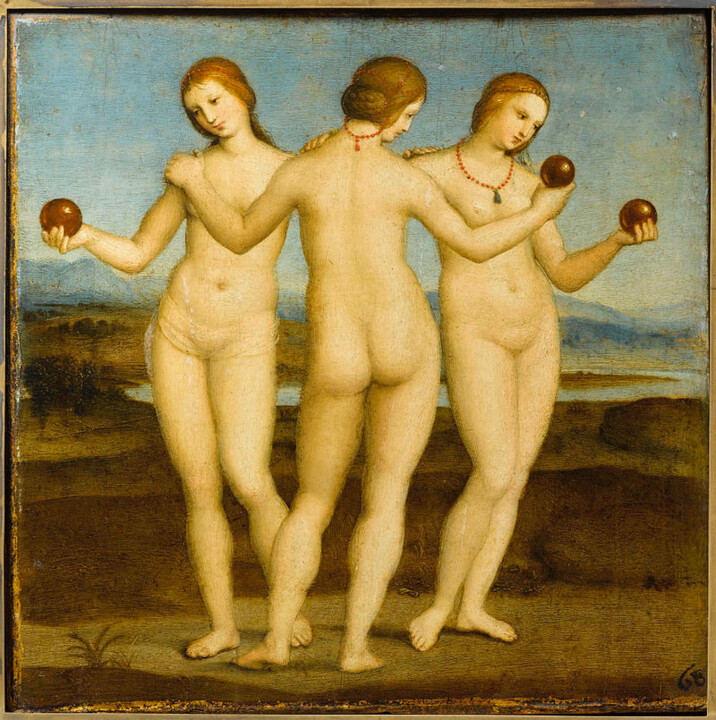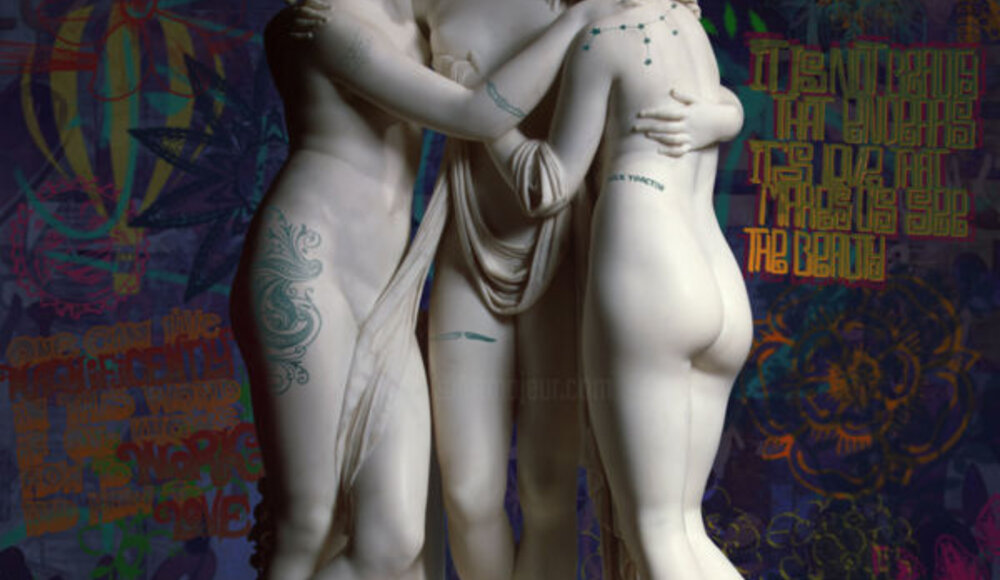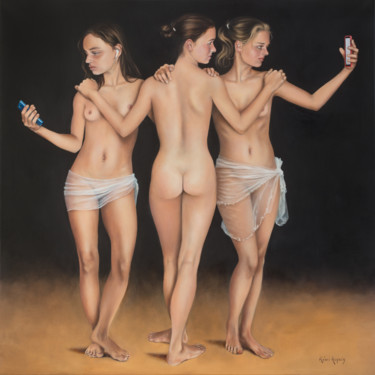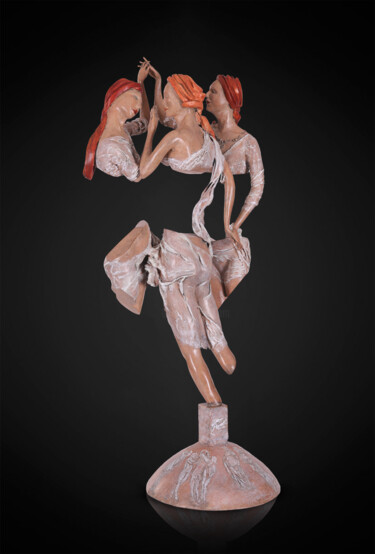 Wilhem Von Kalisz, It's love that makes us see bauty, 2021. Oil / acrylic / digital print / digital painting on canvas, 120 x 100 cm.
Wilhem Von Kalisz, It's love that makes us see bauty, 2021. Oil / acrylic / digital print / digital painting on canvas, 120 x 100 cm.
The Graces are three sister goddesses that Roman mythology drew from the Greek example of the Caryatids, in order to promote the spread of an iconography that, among the most positive of ancient civilizations, was capable of alluding to the harmony achieved through the worship of the arts, nature and vegetation, the foundations of human joy in life. As for the mode of depiction of this "playful" subject, a specific iconography has been imposed since Greek times, so much so that, in the poetic, literary and cultural imagination from then until today, the Graces appear as three naked young women, among whom, one of them, appears turned toward the others, while the latter are facing the viewer. From contemplating the major masterpieces in the history of art depicting this subject, I could see how, over the centuries, it has undergone some modifications, as well as an accentuation of the erotic and sensual side of the effigys. The above is clear from a comparison of three works having the same subject, such as the demure and Renaissance Three Graces by Raphael, the finely sensual neoclassical Graces by Canova, and the complicit and more erotic Graces by Rubens.
 Raphael, Three Graces, 1503-04. Oil on panel, 17 x 17 cm. Chantilly: Condé Museum.
Raphael, Three Graces, 1503-04. Oil on panel, 17 x 17 cm. Chantilly: Condé Museum.
 Canova, The Three Graces ,1812-1817. Marble sculpture. St. Petersburg: Hermitage Museum.
Canova, The Three Graces ,1812-1817. Marble sculpture. St. Petersburg: Hermitage Museum.
 Rubens, The Three Graces, c. 1636. Oil on canvas, 221 X 181 cm. Madrid: Museo del Prado.
Rubens, The Three Graces, c. 1636. Oil on canvas, 221 X 181 cm. Madrid: Museo del Prado.
Speaking of the first masterpiece mentioned, the panel, dated c. 1503, is one of the smallest paintings made by Raphael, as well as the only non-religious-themed work of the artist's Florentine period, who made it under the influence of Pinturicchio and Perugino, in addition to inspiration drawn from the Roman replica of a Hellenistic-era sculpture, which the master could probably observe at the library of Pope Pius II Piccolomini in Siena. The result of these studies is the composition in which three young women in the foreground, naked and embracing, hold spheres, immersed in a hilly landscape from which it is also possible to discern the presence of a stream. As for the globes, they may allude to the Hesperides, nymphs of Greek mythology dedicated to guarding Hera's garden of golden apples, figures analogous to that of the Three Graces, though of less artistic fortune. From a purely symbolic point of view, on the other hand, the aforementioned apples represent immortality, while the Graces allude to the feminine virtues of modesty, beauty, and love, understood as a kind of reward for good life conduct of human beings. Finally, the classical beauty of the nude composites does not seem to allude to mischievous double entendres, whereas, in Canova's later work, due to the increased closeness and complicity between the women, the sensual charge certainly becomes greater. Despite this, the Italian sculptor's Neoclassical style, aimed at expressing the concept of ideal beauty through the physical perfection of the subjects, does not represent a real erotic value, a factor that would develop more in Rubens' later figurative investigation. Returning to Canova's Three Graces, the 1813-1816 masterpiece, commissioned by Napoleon's first wife, namely Josephine de Beauharnais, presents the sisters entwined in a family embrace, within a triangular composition whose apex is represented by the hair of the central girl. In this context a warm emotional expression can be detected, despite the Neoclassical rationalism, which takes shape in the faces of the women intent on manifesting all the spontaneity of their emotional bond. The idea of the "family" takes a back seat in Rubens' Baroque interpretation, as this aesthetic movement valued more the artificial and sensual compositions, dominated by the presence of the serpentine line, used to sinuously model the human body. In the particular case of the Three Graces (1636), the Flemish painter treated the mythological subject following his typical ideal of beauty: opulent bodies with wide hips and small breasts, whose skin, at the joints, creates marked folds. Such peculiarities give voice to a triumph of the flesh and sensuality of women's bodies, which clear and luminous, turn out to be as abundant as the nature around them, probably drawing inspiration from the florid love situation of the artist, who shortly after his marriage, began to display his happiness and vitality through more "erotic" themes.
 Oleg Sergeev, The three Graces, 2015. Pastel on cardboard, 70 x 85 cm.
Oleg Sergeev, The three Graces, 2015. Pastel on cardboard, 70 x 85 cm.
 Tony Rubino, Three Graces graffiti tattoos, 2022. Acrylic / lithography on canvas, 50.8 x 50.8.
Tony Rubino, Three Graces graffiti tattoos, 2022. Acrylic / lithography on canvas, 50.8 x 50.8.
The three Graces in the history of art
From a purely chronological-stylistic art-historical perspective, the earliest depictions of the three Graces, as anticipated, date back to Greek civilization, whose iconography represented the model for later Roman and Renaissance art. In this figurative context, the classical Hellenistic image of the three nude women, arranged so that the central one is seen from behind, while the others flank her frontally, was interpreted in a more innovative way by Botticelli, who, in the fifteenth-century era, captured the aforementioned figures in a more dynamic and innovative "girotondo," a composition that fell outside the more traditional interpretations by great masters such as Francesco del Cossa and Raphael. Subsequently, after the lesser success found by the theme during the seventeenth century, a period in which the work of the aforementioned Rubens, however, stands out, the three Graces returned strongly in vogue within the current of Neoclassicism, whose apex of stylistic refinement is rendered by the sculptural art of the genius of Antonio Canova. From the latter historical moment onward, this subject turned out to be very popular within the narrative of the figurative arts, so much so that it became a "typical" object of depiction by the Pre-Raphaelites, the exponents of Art Deco, and by those of the twentieth-century avant-garde, artists who rendered maidens in the most unthinkable forms and colors, up to the most modern interpretations, among which, particularly noteworthy are those of sculptors Niki De Saint Phalle and Dorit Levinstein. Finally, in addition to the aforementioned artists, the three Graces have also been the subject of attention by Artmajeur artists, who, such as Max Leonhard, Kristina Korobeynikova and Mandy Sand, that have investigated their erotic, expressive and emotional potential by exploiting stylistic features and techniques that are quite distinct from each other.
 Mandy Sand, The Three Graces, 1988. Conté / pencil on paper, 70 x 50 cm.
Mandy Sand, The Three Graces, 1988. Conté / pencil on paper, 70 x 50 cm.
Mandy Sand: The Three Graces
Executed in keeping with the more traditional figurative composition of Hellenic derivation, the drawing of Sand's The Three Graces was probably made through the practice of the particular graphic technique of sanguigna, a drawing tool, which, among the oldest in circulation, consists of hematite reduced to sticks, by means of which forms of a peculiar reddish color can be traced. The latter, which was extremely popular throughout the Italian Renaissance, a time when it was more commonly referred to as "pencil," continued to be a must in drawing during the later Mannerism period, just as evidenced by The Three Graces by Jacopo Carucci, a master who, better known by the appellation Pontormo, created the aforementioned subject, now preserved in the Uffizi Gallery, in about 1535. In the latter masterpiece, the forms, sketched in their chiaroscuro, are defined by means of the outlines, aimed at giving life to nude bodies highlighted in their formal peculiarities by the upper part of the work, in which the dynamism of the arms makes the complicity of the three ladies more interesting, captivating and demurely sensual. Unlike the latter drawing, the work of the artist from Artmajeur appears more static, although, giving movement to the effigies is provided by the rich decorative motifs aimed at adorning their bodies of ancient beauty, intended to bring together the classical model with contemporary imagination.
 Kristina Korobeynikova, Three Graces, 2022. Acrylic on linen canvas, 175 x 135 cm.
Kristina Korobeynikova, Three Graces, 2022. Acrylic on linen canvas, 175 x 135 cm.
Kristina Korobeynikova: Three Graces
The apples gathered in the hands of the three beautiful maidens in Kristina Korobeynikova's partly pointillist painting bring to mind Raphael's masterpiece, anticipated in its take on the mythological theme by the previous interpretation of the subject by Francesco del Cossa, an Italian painter born in 1436, a well-known representative of the 15th-century Ferrara school. In fact, the latter artist arranged the three Graces, nude, standing and holding "spheres" in their hands, within Aprile, one of the frescoes painted, between about 1468 and 1470, inside the Salone dei Mesi of Palazzo Schifanoia in Ferrara, Italy. This painting, executed in order to represent a concrete political manifesto of the greatness of Duke Borso d'Este, is divided into between horizontal bands: an upper one, in which the triumph of Venus appears; a central one, where the sign of the bull and the three "decans" are placed; and a lower one, decorated with scenes of the Este government. In this rich context, the three Graces find their place within the register aimed at narrating the vicissitudes of the goddess of love, depicted as she moves forward on a festively paraded chariot pulled by two white swans, that moves by slipping over the waters of a river. In this mode of movement Venus is intent on celebrating her victory over Mars, who is depicted, wearing his medieval knight's armor, kneeling before her. In the very background of this episode, set within a hilly landscape, it is possible to discern, to the right of Venus, positioned on a rock, the three Graces, surrounded by figurative elements charged with multiple symbolic meanings, many of them alluding to fertility and love, a sentiment that is most explicitly echoed in the embrace between young people captured in the painting's foreground.
 Max Leonhard, Three Graces, 2021. Pigments on canvas, 206 x 156 cm.
Max Leonhard, Three Graces, 2021. Pigments on canvas, 206 x 156 cm.
Max Leonhard: Three Graces
Through Leonahard's partly metaphysical interpretation, it is instead possible to reconnect with twentieth-century depictions of the Three Graces, taking place, first and foremost, in the popularity that such a subject enjoyed among the historical Cubist avant-garde, well exemplified by Robert Delaunay's 1912 masterpiece, The Three Graces. This oil on canvas, was conceived with the intention of translating, through a modern visual idiom, a theme of timeless poetics and elegance, which the French master also explored in earlier works, among which, notable for notoriety, La Ville de Paris and an unfinished sketch from 1909, inspired by a fresco of the same subject from Pompeii. Returning to The Three Graces, the painting dates and a golden period in Delaunay's career, who was consolidating his position as a great artist of the time, as well as an important exponent of Cubism. Precisely with regard to the latter movement, it is worth highlighting how the French artist took up the Picassian shattered and concatenated interpretation of planes, although, nevertheless, he retained a greater visual accessibility to the subjects interpreted. Finally, the work already boasts a specific treatment of lights, which translated into the sense of refraction created by the shimmering planes, anticipates the later Orphic Delaunay, author of such masterpieces as, for example, The Joy of Living (1930) and Circular Forms (1930).


 Olimpia Gaia Martinelli
Olimpia Gaia Martinelli











